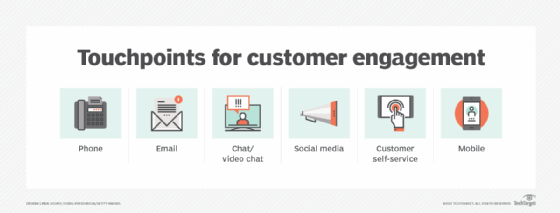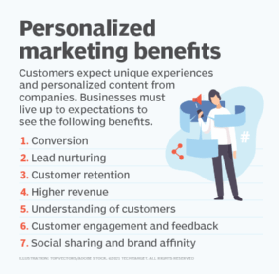AIDA marketing model
What is the AIDA model of marketing?
The AIDA marketing model is a framework that describes a buyer's journey through four key stages: Attention, Interest, Decision and Action. The model and its steps are used in marketing, advertising, and sales to help businesses determine how they should craft their communications for each of the four stages, and ultimately encourage buyers to complete a purchase.
AIDA is an acronym that represents the steps required for successful marketing communications: Attention (or, in some variations, Awareness), Interest, Desire (or, in some variations, Decision) and Action. All customers go through these steps along their buyer's journey. To capture their attention at various touchpoints in the journey and support them in making a final purchase, businesses must modify their communications for each stage of the AIDA model.

During the Attention/Awareness stage, a company's customer messaging should capture their attention by creating brand awareness. To move them to the Interest stage, the content should foster curiosity about the company's products and services.
Moving the customer to the Desire/Decision or the "I want it" stage requires communications that conveys the product's value and helps them to realize that they "need" it. In the final stage, the content must spur the customer into completing the product purchase.
One similarity between AIDA and other marketing funnels is that each stage has fewer consumers than the previous one. This is because it's usually easier to attract the attention of more potential customers (the first A in AIDA) than to get them to complete a purchase (the second A in AIDA). As a result, the number of customers going through the funnel from the first stage to the last will keep decreasing.
Explore the relationship of buyer personas to customer journeys and journey maps.
What are the four stages of the AIDA model?
The four stages of AIDA are as follows:
Attention (or Awareness)
To make customers aware of offerings, a marketer must catch their attention. Various approaches, such as placing ads in unusual but noticeable places, can work. Increasingly, marketers are using content personalization. Personalized messages, like those used in one-to-one marketing, are hard to ignore and more likely to capture a potential buyer's interest than generic "spray and pray" marketing and proposals.

Similarly, shock value advertising that uses graphic or provocative images garners attention by provoking sharp emotional reactions. Companies should use this approach with care, however. If the campaign doesn't sync with their overall brand image, it can damage their reputation and bottom line.
Interest
After attracting a potential customer's attention, the company must pique their interest and hold it long enough to communicate information about their product or service. An effective way to maintain a potential customer's interest (and move them toward the D stage of the AIDA funnel) is to present them with concise, well-paced information, delivered by an interesting character, voice actor or mascot. Information that's engaging, persuasive and presented in the right way to the target audience enables buyers to learn more about the product and understand its benefits, increasing the probability they will decide to buy it.
Desire (or Decision)
Companies can stimulate a desire to buy their product by showing how it is superior to similar products and by demonstrating its versatility. Essentially, this is the presentation of its value proposition. A reliable method here is to build an emotional connection with the customer rather than focusing on the transactional aspects of a potential sale.
To encourage decision-making, companies also try to gain buyers' trust by getting the buyer to interact with the company's content, by getting them to envision a brighter future with the company (and its product), and by establishing "social proof." Ultimately, the goal is to induce the consumer to select the company's offering and complete the purchase. Here's where content like blogs, case studies and testimonials can be powerful.
Action
The final step in AIDA is closing the sale and convincing the customer to act on their interest by presenting them with a compelling call to action (CTA). The business might also need to overcome any objections the buyer might still have, say, by first presenting a higher price for the product and then lowering it to entice purchase. Buyers might also be presented with offers, such as buy-two-for-the-price-of one, get free shipping and more to further encourage their move toward a sale. Improving the product's perceived value in the customer's mind can motivate them and alleviate their doubts.
It's important to leave the customer with a lasting positive impression of the product and company, even if they do not make the purchase. A positive impression tends to linger in customers' minds and there's always a chance they will return and make a purchase later.
History of the AIDA model

American businessman and advertising advocate Elias St. Elmo Lewis introduced the AIDA model in the late 19th century and early20th century. The model didn't emerge fully formed all at once. Initially, Lewis only introduced the ideas of attract attention, maintain interest, create desire, i.e., the A-I-D parts of the AIDA model. He discussed these ideas in numerous newspaper columns, magazines, and his own book, Financial Advertising. It was only later that he added get action to the original slogan. His ideas eventually evolved into the AIDA model.
Today, the model is a cornerstone of modern marketing, to the extent that missing even one step is thought to almost guarantee an unsuccessful result. In the modern era, the AIDA framework has been slightly updated to include another factor: Retention. The updated "AIDAR" model enables modern marketers to also think about the importance of building customer relationships in order to retain them.
Some marketers also use the AIDAL model, where the L stands for Loyalty. In this stage, companies focus on ensuring that customers have a positive experience in order to generate brand loyalty and boost repeat sales.
Tips for using the AIDA model effectively
- Clarifies customer communications. The AIDA model enables businesses to clarify the what/how/when aspects of customer communications during each stage of the customer journey. To generate effective results with the model, it's important to keep these best practices in mind.
- Invest in content marketing. High-quality content is essential at every stage of the buyer's journey. AIDA investment in content marketing can attract customers to the company, encourage their interest in its products or services, ignite a desire to purchase those products or services, and finally, overcome lingering objections to complete the purchase.
- Demonstrate the "why" with engaging storytelling. Information that not only conveys the what of a product but also its why is more likely to resonate with customers and get them to move down the AIDA marketing funnel. Interesting stories generate interest and excitement, demonstrate that the company and its products are aligned with the buyer's needs, and encourage affinity between buyers and the brand.
- Keep engaging prospects with interesting, personalized content. Personalization is highly effective at retaining a buyer's interest and getting them to choose one brand over another.
- Present a clear CTA. The ask of a prospective buyer should always be clear. It should lead a buyer to where the company wants them to go (and do what the company wants them to do). Good CTAs reduce the friction for buyers while increasing their incentive. That's why a bland, generic CTA like "click here" rarely encourages action while a definitive, high-incentive CTA like "start my free trial" does.
Personalized marketing can help companies treat customers as individuals while improving customer retention and brand affinity. Read more about the benefits of creating a personalized content marketing strategy.
